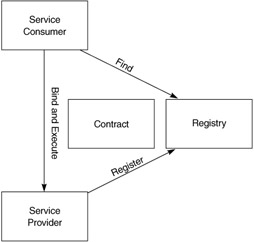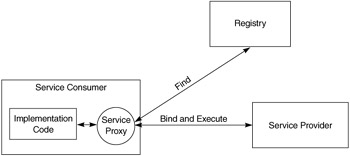SOA Entities
The "find, bind, and execute" paradigm as shown in Figure 2.3 (Talking Blocks 2001) allows the consumer of a service to ask a third-party registry for the service that matches its criteria. If the registry has such a service, it gives the consumer a contract and an endpoint address for the service. SOA consists of the following six entities configured together to support the find, bind, and execute paradigm.

Figure 2.3: The "find-bind-execute" paradigm.
Service Consumer
The service consumer is an application, service, or some other type of software module that requires a service. It is the entity that initiates the locating of the service in the registry, binding to the service over a transport, and executing the service function. The service consumer executes the service by sending it a request formatted according to the contract.
Service Provider
The service provider is the service, the network-addressable entity that accepts and executes requests from consumers. It can be a mainframe system, a component, or some other type of software system that executes the service request. The service provider publishes its contract in the registry for access by service consumers. Chapter 3 describes the issues involved with creating a service provider by using component-based development techniques.
Service Registry
A service registry is a network-based directory that contains available services. It is an entity that accepts and stores contracts from service providers and provides those contracts to interested service consumers.
Service Contract
A contract is a specification of the way a consumer of a service will interact with the provider of the service. It specifies the format of the request and response from the service. A service contract may require a set of preconditions and postconditions. The preconditions and postconditions specify the state that the service must be in to execute a particular function. The contract may also specify quality of service (QoS) levels. QoS levels are specifications for the nonfunctional aspects of the service. For instance, a quality of service attribute is the amount of time it takes to execute a service method.
Service Proxy
The service provider supplies a service proxy to the service consumer. The service consumer executes the request by calling an API function on the proxy. The service proxy, shown in Figure 2.4, finds a contract and a reference to the service provider in the registry. It then formats the request message and executes the request on behalf of the consumer. The service proxy is a convenience entity for the service consumer. It is not required; the service consumer developer could write the necessary software for accessing the service directly.

Figure 2.4: A service proxy.
The service proxy can enhance performance by caching remote references and data. When a proxy caches a remote reference, subsequent service calls will not require additional registry calls. By storing service contracts locally, the consumer reduces the number of network hops required to execute the service.
In addition, proxies can improve performance by eliminating network calls altogether by performing some functions locally. For service methods that do not require service data, the entire method can be implemented locally in the proxy. Methods such as currency conversion, tip calculators, and so on, can be implemented entirely in the proxy. If a method requires some small amount of service data, the proxy could download the small amount of data once and use it for subsequent method calls. The fact that the method is executed in the proxy rather than being sent to the service for execution is transparent to the service consumer. However, when using this technique it is important that the proxy support only methods the service itself provides. The proxy design pattern (Gamma et al. 2002) states that the proxy is simply a local reference to a remote object. If the proxy in any way changes the interface of the remote service, then technically, it is no longer a proxy.
A service provider will provide proxies for many different environments. A service proxy is written in the native language of the service consumer. For instance, a service provider may distribute proxies for Java, Visual Basic, and Delphi if those are the most likely platforms for service consumers. Although the service proxy is not required, it can greatly improve both convenience and performance for service consumers.
Service Lease
The service lease, which the registry grants the service consumer, specifies the amount of time the contract is valid: only from the time the consumer requests it from the registry to the time specified by the lease (Sun Microsystems, Jini Technology Core Specification, 2001). When the lease runs out, the consumer must request a new lease from the registry.
The lease is necessary for services that need to maintain state information about the binding between the consumer and provider. The lease defines the time for which the state may be maintained. It also further reduces the coupling between the service consumer and the service provider, by limiting the amount of time consumers and providers may be bound. Without the notion of a lease, a consumer could bind to a service forever and never rebind to its contract again. This would have the effect of a much tighter coupling between the service consumer and the service provider.
With a service lease, if a producer needs to somehow change its implementation, it may do so when the leases held by the services consumers expire. The implementation can change without affecting the execution of the service consumers, because those consumers must request a new contract and lease. When the new contract and lease are obtained, they are not guaranteed to be identical to the previous ones. They might have changed, and it is the service consumer's responsibility to understand and handle this change.
While Web services provide support for many of the concepts of SOA, they do not implement all of them. They do not currently support the notion of a contract lease. Also, no official specification provides QoS levels for a service. An organization cannot implement a complete service-oriented architecture given these limitations with Web services. In addition, service consumers can execute Web services directly if they know the service's address and contract. They do not have to go to the registry to obtain this information. Today, in fact, most organizations implement Web services without a registry. Consequently, the extent to which an organization implements an SOA with Web service varies greatly.
EAN: 2147483647
Pages: 210